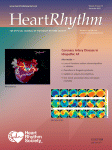Heart Rhythm:心脏再同步化治疗远期死亡率变异颇大
2012-12-05 高晓方译 Heart Rhythm
美国学者的一项研究表明,心律转复除颤器(CRT-D)再同步化治疗之后,远期死亡率依据基线传导缺陷和重塑反应而存在较大变异。论文于2012年11月26日在线发表于《心律》(Heart Rhythm)杂志。 此项研究对MADIT-CRT亚组患者进行了评估。MADIT-CRT对1820例接受心脏再同步除颤器(CRT-D)或仅除颤器(ICD)治疗的患者进行了比较。在左束支传导

美国学者的一项研究表明,心律转复除颤器(CRT-D)再同步化治疗之后,远期死亡率依据基线传导缺陷和重塑反应而存在较大变异。论文于2012年11月26日在线发表于《心律》(Heart Rhythm)杂志。
此项研究对MADIT-CRT亚组患者进行了评估。MADIT-CRT对1820例接受心脏再同步除颤器(CRT-D)或仅除颤器(ICD)治疗的患者进行了比较。在左束支传导阻滞(LBBB)和非LBBB的患者中,利用Cox比例回归分析评估治疗效果对死亡率的影响。在1196例于1年时复查超声心动图的患者中,通过基线传导和1年左室收缩末期容积(LVESV)变化分析CRT-D对远期死亡率的影响。
结果显示,CRT-D未降低总体死亡率(P=0.72)。在伴LBBB和CRT-D的761例患者中,对临床协变量进行校正之后死亡率呈降低趋势。在出现(有效者)和未出现(无效者)LVESV减小≥30%的患者中进一步评估CRT-D对死亡率的影响。CRT-D显著降低了LBBB有效者的死亡率(P=0.027),LBBB无效者则无此效应。与之相反,CRT-D使非LBBB有效者的死亡率出现升高趋势;非LBBB无效者的死亡率则显著升高(P=0.011)。

作者:高晓方译
版权声明:
本网站所有注明“来源:梅斯医学”或“来源:MedSci原创”的文字、图片和音视频资料,版权均属于梅斯医学所有。非经授权,任何媒体、网站或个人不得转载,授权转载时须注明“来源:梅斯医学”。其它来源的文章系转载文章,本网所有转载文章系出于传递更多信息之目的,转载内容不代表本站立场。不希望被转载的媒体或个人可与我们联系,我们将立即进行删除处理。
在此留言




#心脏再同步化#
42
#变异#
36
#ART#
31
#HEART#
40